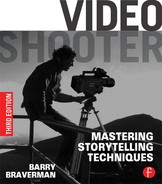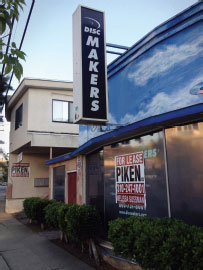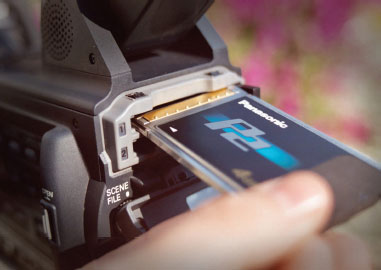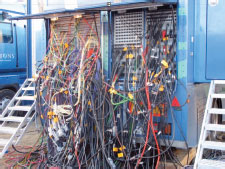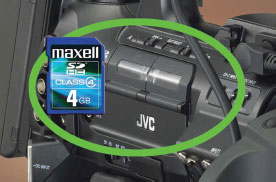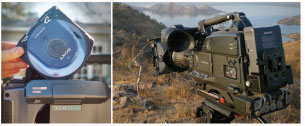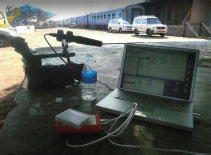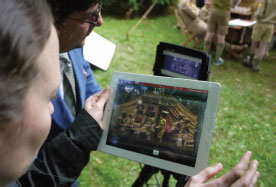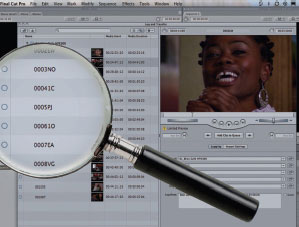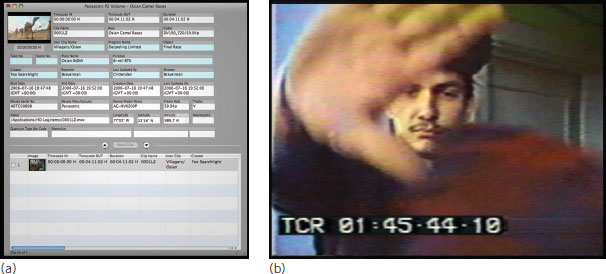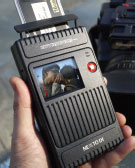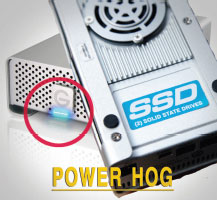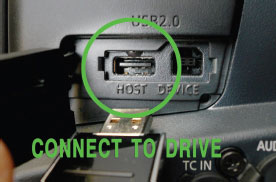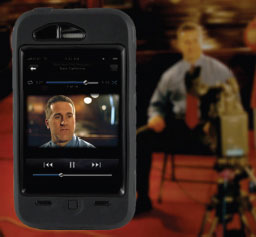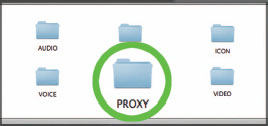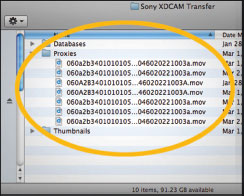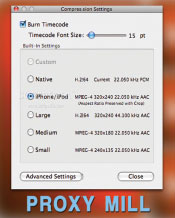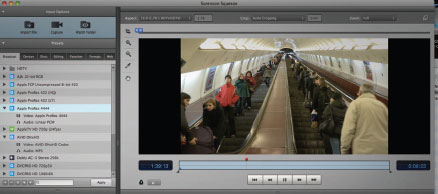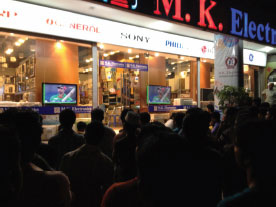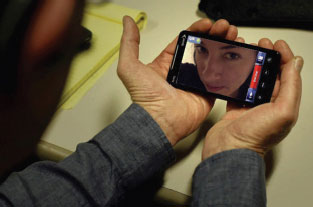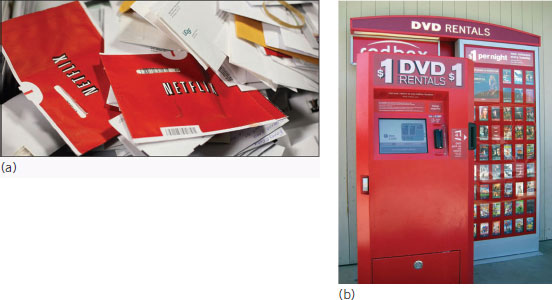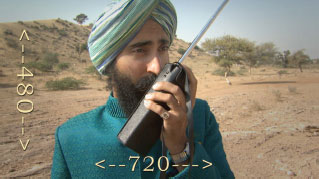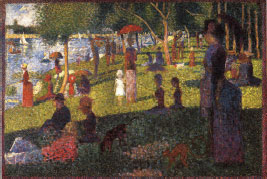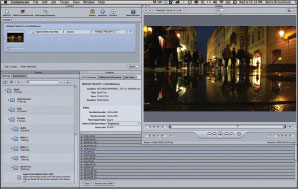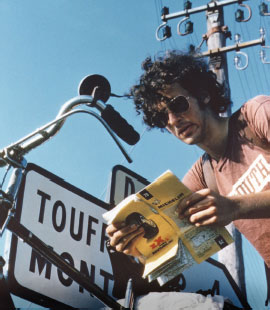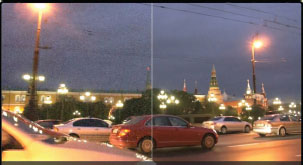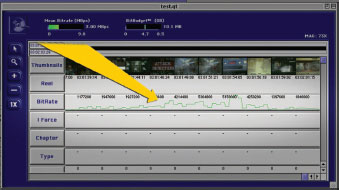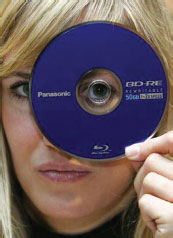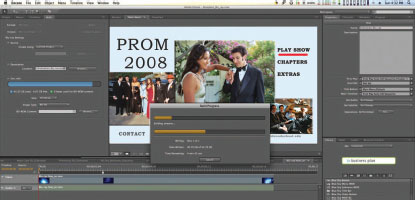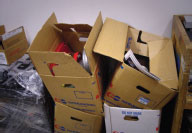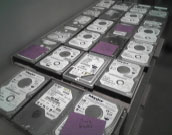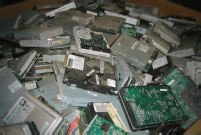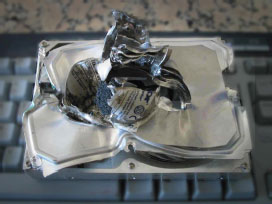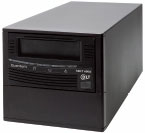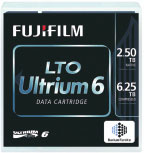Spiritualist Eckhart Tolle in his best seller A New Earth1 notably observed that we really only act out of two emotions: love and fear. If we aren’t acting out of love, then we’re acting out of fear, and the tapeless, file-based world has thrust plenty of it on us. Our challenge as shooters in this digital-run-amok world is to confront our fears and replace them to the extent possible with a love for the new ways of doing things.
As Tolle would say, we have no choice but to accept the Is-ness of the medium. In my workshops, I sometimes find resistance from my cinematography students who balk at the need to learn post-camera solutions. They say (or are taught) that audio is someone else’s job; that postproduction stabilization, recomposition, and filtering are not their concern; that the director, producer, and screenwriter all have their roles, which are unrelated to the shooter’s role, which is to shoot. Just shoot. Truly one has to wonder what world or decade these students are preparing for.
FIGURE 13.1
Look around. The Is-ness is upon us. We have to accept the reality of a rapidly evolving media landscape.
FIGURE 13.2
Today’s cameras no longer shoot video. They capture data to solid-state memory, which requires a computer-centric IT-based workflow.
FIGURE 13.3
Twenty years ago, Firewire ushered in the desktop video revolution. Today, it has now been almost entirely supplanted by USB, a nonvideo interface.
FIGURE 13.4
Who says we need a file-based workflow? This very analog scene is from the Turin Winter Olympics in 2006.
FIGURE 13.5
Camera startup from flash memory is instantaneous without waiting for belts and pulleys to get up to speed. Some cameras offer a dual-record capability, providing a simultaneous backup.
FIGURE 13.6
Optical disc cameras provide an archival copy for backup—a consideration for folks fearful of corrupting or inadvertently deleting original files from solid-state media. Similar to traditional tape cameras, Sony’s disc models require hauling cases of media to remote locations. Solid-state cameras have no such requirement: We haul stacks of hard drives and backups of hard drives instead.
There was a time we blissfully rolled off a bunch of cassettes, handed them to a production assistant, and submitted an invoice. End of story. Nice.
Today, thanks to solid-state cameras and the vagaries of a computer environment, there are many possible workflows. Shooting behind the scenes for The Darjeeling Limited, I had no reliable AC power, dirt and sand were everywhere, and my working space aboard the moving train in India was just 19 inches (50 cm) across. Making matters worse, I had only three 8GB cards for my P2 camera—a total of 1-hour of running time, necessitating the periodic crash off-loading of cards at various times in the day.
FIGURE 13.7
Given today’s all-file based world, every project may require a slightly different workflow. I set up this improvised offload station under a tree in Jodhpur, India, for The Darjeeling Limited.
The entertainment industry created the Material eXchange Format (MXF) to facilitate the handling of media files from image capture through postproduction and digital cinema. Unfortunately, given a 700-page standard, there were bound to be implementation differences.
Panasonic’s MXF P2 format assigns a random file name to the individual media files. While this creates the discrete audio and video streams necessary for editing, the splitting of assets in this way complicates the playback and management of MXF files on the desktop. The cryptic naming of files is especially unhelpful, and any attempt to assign more appropriate names disrupts the MXF structure and renders the asset inaccessible.
Sony’s XDCAM MXF format produces files incompatible with Panasonic’s P2. The two systems vary in their subfolder hierarchy and how the A/V files are captured: XDCAM multiplexes2 the audio and video into a single stream, the preferred strategy in a broadcast environment. By maintaining separate audio and video streams, P2 is optimized for the production of feature films, commercials, documentaries, corporate, and other non-broadcast programs. 3
FIGURE 13.8
(a) The P2 layout of folders appears logical on the computer desktop. The XDCAM thumbnail editor (b) marks, deletes, and organizes clips into folders, prior to off-loading to an external device or server.
FIGURE 13.9
WiFi-enabled camcorders and DSLRs allow direct editing via an iPad or tablet obviating the need to offload memory cards to an external drive!
FIGURE 13.10
MXF’s cryptic naming pattern links the format’s numerous components. Once inside the NLE bin or browser, a clip may be renamed without limitation.
Several years ago, a popular U.S. news show aired a segment in which a noted plastic surgeon appeared irrational. The doctor, not happy with his depiction, threatened to sue the network but agreed not to do so on the condition that the interview never run again. Four years later, a young producer for another show rediscovered the original broadcast and, unaware of the prohibition, reused portions of the doctor’s unflattering comments. This time in the face of almost certain litigation, the network fired the producer and settled quickly with the physician for a large cash sum.
Today this incident might have been avoided given proper management of the clip’s metadata. Metadata is data about data that include, among other things, technical details like frame rate, resolution, and compression format. It also may include the production title, GPS tags, shooter and producer IDs, and use prohibitions, if any. This metadata is made a permanent part of the clip, instantly searchable with a click of a mouse from inside the NLE.
Metadata support is crucial for effective digital asset management (DAM). For Harry Potter and the Order of the Phoenix4 in 2007, producers conforming a scene for the digital intermediate 5 laboriously pawed through 120 different versions of a single shot; no one could say with certainty which version was actually approved by the director. Adding a simple annotation to the desired clip’s metadata could have saved the hassle and the expense of searching for hours in the DI room.
FIGURE 13.11
A key advantage of a file-based workflow is the ability to manage and search metadata. The custom fields in this clip’s metadata (a) can accommodate a range of input from camera setup and lens choice to location notes and restrictions on use.
Given videotape’s inherent fragile nature and trouble-prone mechanical transport, the new file-based systems should make us feel more secure, despite the apprehension stemming from the offloading of media cards and erasing of the original camera files.
Nervous Nellies point to the volatility of data and the need to store master camera footage (albeit temporarily) on less than reliable bus-powered hard drives. The same Nellies point to the slow transfer process and the need for multiple backups to ensure file integrity and peace of mind. For these folks, a tangible cassette tape or disc provides welcome solace, a security blanket in a digital age when critical data can neither be seen nor touched, and so may be unknowingly mishandled, corrupted, or deleted.
We shooters are a fearful breed. We worry about things whether they matter or not: Do our sensors have enough pixels? Are we selling our souls when shooting 4:2:0? Is long GOP going to diminish us as human beings? These are the things that keep us awake at night.
The failure of a hard drive is not a prospect that sits well with us; indeed, we know how most HDDs are guaranteed for only 1 to 3 years. Hard drive failure may have a variety of causes including poor maintenance, subjecting the drive to excessive heat or shock, use of an incorrect or defective power supply, or failure of a connector or controller board. Whatever our fears real or imagined, the shooter understands that HDD failure is an occupational hazard that can strike at any time any place with devastating results.
FIGURE 13.12
With the advent of high-capacity memory cards the crash off-loading of original camera files has been largely eliminated.
FIGURE 13.13
The Nexto verifies offloading of a camera’s memory cards to the unit’s internal HDD. The built-in LCD screen provides confirmation of a successful transfer.
With no moving parts, the solid-state drive (SSD) confronts head-on the source of our anxiety. SSDs are much more reliable, lightweight, and resistant to heat, shock, and G-forces.
Not constrained by a spinning platter or a fitful mechanism, the SSD operates at the full bandwidth of the bus up to 1,600 Mbps via eSATA at RAID 0.6 If fear still compels your desire for redundancy a RAID 1 SSD array with 100% mirroring can still sustain 960 Mbps.
High-capacity SSDs offering USB 3.0 and Thunderbolt 7 will soon eclipse mechanical hard drives for most applications. For shooters, the greatest threat then will not be failure of the drive but physical loss or theft of the SSD itself.
FIGURE 13.14
A mini SSD RAID can be configured for speed RAID 0, safety RAID 1, or JBOD (Just a Bunch of Drives). An idle SSD consumes no power except for the illuminated LED!
FIGURE 13.15
Off-loading via USB to a computer? Use DEVICE mode. To offload directly to an external drive use HOST mode. The HDD or SSD must be formatted via the camera.
There’s a growing impetus among shooters for mobile devices to play a more active role for monitoring and review. Some cameras like the Panasonic HPX600 can be fitted with a proxy encoder for streaming MPEG-4 audio and video to the Web or handheld device. XDCAM cameras produce proxy videos by default and so do not require a supplemental encoder card.
The preparation of iPhone dailies is simple. A media card or a camcorder containing the proxy videos is mounted on a computer and a new playlist is created in iTunes. It should be named logically, for example, “01_production_date.” The proxy files are then dragged into the playlist and synced to the iPhone in the normal way. The same procedure applies to XDCAM proxies, which may be brought into iTunes directly from the disc or the SXS card or retrieved after capture from the XDCAM Proxy Folder.
FIGURE 13.16
The iPhone and iPad are increasingly popular production tools. Simple edits can be performed and sent instantly to absentee producers on far-off golf courses.
FIGURE 13.17
The latest Panasonic P2 cameras place the MPEG-4 proxy files in the appropriate folder. For video dailies create a new playlist in iTunes, drag in the proxy videos, sync to the iPhone—and voilà!
FIGURE 13.18
XDCAM cameras create low-resolution proxy files that can be used to create an iTunes playlist. The files’ naming convention leaves something to be desired.
FIGURE 13.19
Cameras without proxy encoding can use Imagine Products’ Proxy Mill to prepare iPhone dailies. The Proxy Mill generates MPEG-4 files from P2 or QuickTime (.mov) sources.
Some of us belong to pricey health clubs equipped with the latest machines and smoothie bars. We pay thousands of dollars, euros, or pounds each year for the privilege, so why is it we don’t use these clubs more often, or even at all? The answer is simple: Most clubs are not all that convenient, especially if they’re located more than 10 minutes from work or home.
This rule of use versus nonuse also applies to our digital tools. For the shooter, there are many post-camera tools with powerful features that could improve our images, but the software is too complex or inconvenient to access. In their own way, the benefits of these programs are located too far away and so, like the health club, are likely to go unused.
This isn’t the case with Sorenson Squeeze, whose broad capabilities are intuitive and easy to access. It’s hard to think of a platform or format that is not supported: WebM, HTML5, Flash, H.264, AVC-Intra, and XDCAM. You’ll still need a dedicated encoder for digital cinema and 3D but short of that, Squeeze is a one-stop shop for digital encoding for whatever display venue you might be contemplating.
FIGURE 13.20
Behold the shooter’s Three Noble Truths: Yes, you need Photoshop; yes, you need an NLE; and yes you need Sorenson Squeeze to output your project according to the dictates of your own true self.
FIGURE 13.21
Enjoying a cricket match outside a TV shop window in Dhaka in 2012. Not everyone is inclined to watch such programs on a mobile phone, although in Japan a growing number of smartphone users do.8
FIGURE 13.22
Today’s shooter must adjust to the latest trends. Case in point: Small-screen viewing will depend on close-ups more than ever. So tell me why you need that 5K camera again?
Interestingly even as rentals on digital platforms continue to grow at 5% per year, consumers in North America are still renting DVD and Blu-ray discs in great numbers. Two-thirds of all U.S. film rentals in 2012 were still being placed through Netflix’s mail service, Redbox kiosks, and the few surviving retail shops such as Blockbuster. Subscription-based streaming services, pay TV, and VOD accounted for the remaining one third. 9
Given this reality, the shooter looking to the near future would be wise not to forget the standard-definition DVD. Whether shooting feature films, music videos, or high school plays, DVD continues to play a significant role, especially in the fast-growing regions of Asia and Africa. This will likely remain the case even as digital streaming in the West becomes the predominant distribution vehicle.
Because so much craft and discipline go into creating a compelling and well-performing DVD, it makes sense that we accommodate to some degree the format’s requirements. It matters less that our images look great out of the camera or NLE. What really matters is how our images look at the end of the digital rainbow whether delivered via the Web, pay TV, or a DVD player.
The shooter can use various strategies to improve the quality of DVD output. Shooting 24p makes sense since DVD and Blu-ray players are native 24p devices. Movie studios originating at 24 FPS logically encode their feature films at 24 FPS. Relying on the player to perform the upconversion to 29.97 FPS NTSC or 25 FPS PAL, the DVD shooter can capture, edit, and encode at 24 FPS (actually 23.976 FPS), and reduce the file size of a finished program by 20%. This means more bits can be allocated to each second of video with a concomitant increase in sharpness and detail. The reduction in objectionable artifacts is a major reason for the improved look of DVD programs captured, finished, and encoded at 24p. 10
DVD’s high compression underlies the need to monitor a camera’s detail level, because this can have a dramatic impact on the look of the encoded images. With camera detail set too high, the hard edge around objects is emphasized complicating compression along the transition boundary. Raising or lowering camera detail affects the thickness of this edge, and with it the potential for blocking artifacts that may arise during video playback.
FIGURE 13.23
Despite the growth of the web and other digital platforms DVD still dominates the home-video market and will likely do so for several more years.
We are concerned foremost with the integrity of our images, and so highly compressed digital platforms like DVD substantially impact on how viewers see and judge our work. Whether we like it or not, our meticulously lit doted-over images will be compressed on the order of 40:1 or more, and that compression better be done right and with all due respect.
Ideally, the shooter ought to retain control over the encoding process. Other factors having an impact on the shooter’s craft such as lens performance, camera setup, and filter nuances pale in comparison to the savagery of compressing our images for the Web, mobile phone, or DVD. Consider the complexity of this task—see Chapter 4—and it’s easy to see how the delivered program no matter how well-crafted can be transformed into a Seurat painting.
High-compression snafus especially concern the DSLR shooter, who incurring a bevy of incamera artifacts must make a concerted effort to remediate these issues in post. DSLR artifacts such as moiré and macroblocking can be especially disconcerting. Your job as a new-breed shooter-storyteller is to mitigate such defects prior to encoding for final output.
FIGURE 13.24
Standard definition DVD requires MPEG-2 long-GOP encoded assets at 720 × 480 NTSC or 720 × 576 PAL. Encoding for the Web and mobile devices allows much greater flexibility.
FIGURE 13.25
Compression artifacts such as banding and macroblocking haven’t been art for a while! This is Seurat’s A Sunday Afternoon on the Island of La Grande Jatte, painted in 1884.
The video storyteller understands that encoders may favor some compression parameters over others. One encoder may work well with high-action sports such as rodeos, but perform less admirably when facing a Halloween parade at night featuring complex colors and costumes. To the adept shooter, the new world of HD, MPEG-2, H.264, and VC-1 11 means understanding a range of encoders. No single tool can be expected to do it all, even encoders costing tens of thousands of dollars.
FIGURE 13.26
Engineers working within narrow constraints must juggle the demands of good color and contrast with adequate motion estimation. Apple Compressor has improved in recent years with lower noise and less image softening.
Whether shooting for the Web, DVD, or another compressed medium, the shooter must be aware of scenes that can cause trouble for encoders. Fades and dissolves to and from static high-contrast scenes require extra scrutiny. Wafting smoke, expanses of water, rustling leaves, and falling snow are also tricky. The smart shooter recognizes these potential problem areas and endeavors to stay on top of them from image capture through postproduction.
FIGURE 13.27
The shooter must be aware of scenes that challenge the media encoder. Fast-moving objects like this London taxi can be problematic.
FIGURE 13.28
Expanses of water with gently shifting waves are notoriously difficult to compress. Be sure to scrutinize such areas for potential artifacts.
THE NOISE-REDUCTION IMPERATIVE
We must take care to minimize noise in our original recordings, as the encoder may find it difficult to distinguish the image detail we want from the noise we (presumably) don’t want. The use of an on-camera tightening filter such as the Tiffen Soft/FX or Schneider Digicon can help suppress the blotchiness and swirling noise in the unsupported shadows and textureless monochromatic areas, and so may improve the look of the outputted program.
Besides turning down detail and applying light camera diffusion, noise reduction may also be applied inside the NLE. Many encoders including Compressor have a built-in noise reduction capability of limited effectiveness. The application of noise reduction must always be weighed against the loss of picture detail in the weaker shadow areas.
FIGURE 13.29
A monochromatic sky devoid of texture may exhibit objectionable noise in the encoded program. Reducing the detail in-camera or employing a weak diffusion filter may help.
FIGURE 13.30
Software tools like the Magic Bullet Denoiser and Neat Video can help reduce the noise from elevated camera gain. The original scene is at left; the treated scene at right.
A clean, crisp image with good contrast is normally our goal, and so it would seem to make sense to encode with as high a bitrate as possible. We are constrained, however, by the delivery system—the bandwidth available for the Web, the connection speed for mobile devices, and the DVD and Blu-ray video specifications.
In cable and satellite TV the MPEG video streams must move through a pipe of finite size. The program packages or Groups of Pictures (GOPs) proceed on what might be regarded as a conveyor belt. To move multiple program streams in the most efficient manner the belt must operate at a constant speed with each package being of roughly equal size, as packages of varying girths might get stuck and clog the pipe. At a constant bit rate (CBR), exploding battleships and talking heads receive the same allocation of bits regardless of the scene’s complexity.
Variable bit rate (VBR) encoding adjusts the speed of the conveyor to support different size packages and so is more efficient since bits scavenged from static scenes like a reporter’s stand-up can be reassigned to action scenes such as a barroom brawl.
FIGURE 13.31
VBR adjustments in the bit stream take place at the GOP level in as few as four frames in NTSC. For DVD demo reels and brief programs of 15 minutes or less, CBR yields the best results at a steady 8.5 Mbps. Be sure to encode the audio to Dolby stereo 2.0, or you won’t be able to burn your DVD!12
Who can forget the format wars of 2008 that left HD-DVD in the digital dust? HD-DVD ran a good campaign, offering greater flexibility, more accessible authoring tools, and better compatibility with existing DVD, but in the end, with the support of the Hollywood studios, Blu-ray ultimately prevailed.
Since the cessation of hostilities, Blu-ray’s fortunes have been lackluster. Despite the $2 billion dollars in U.S. sales in 2011, 13 the format remains, as Steve Jobs once so elegantly stated, “a bagful of hurt.”
For the average shooter and content creator, the prospect of replicating Blu-ray discs is not practical. The major reason is an onerous licensing scheme that until recently required thousands of dollars in fees per title. The fee structure established for the Hollywood studios placed commercial Blu-ray discs out of reach for most corporate, business, and event applications.
The Advanced Access Content System (AACS) is designed to thwart piracy by preventing playback of Blu-ray discs without proper authentication. 14 It is a crude stick that works too well, to the detriment of the format and those who would like to adopt it.
Nevertheless, Blu-ray disc titles can be duplicated, that is, burned as one-offs, without incurring AACS fees. Unfortunately, the compatibility of Blu-ray recordable discs on some players can be sketchy. A short-running-time BDMV screener or demo reel utilizing intraframe-only compression may be burned to DVD-R 15 but the resultant disc may confound some high-end players that suspect pirated content and refuse to play it. In this respect, the dirt-cheap players from China are more forgiving, merrily playing back BDMV or AVCHD volumes from recordable media without a care in the world.
FIGURE 13.32
Keeping an eye on the latest technology? Uprezzed from standard definition, 1080p DVD can look nearly as good as an original Blu-ray title. The perception that DVD is “good enough” has diminished the public’s interest in the high-definition disc format.
FIGURE 13.33
Adobe Encore supports the output of DVD and Blu-ray titles to recordable media. Apple offers no BD authoring solution—and is not likely to.
The writing is in the cumulous. The industry is moving rapidly to the cloud, which promises a more collaborative and shared environment. The cloud is a reflection of the expanding global marketplace as production teams can span continents and time zones, and shooters and film-makers can work wherever they want to.
The Internet has become a vast media network with more than 6 billion active mobile phones, many with broadband access. 16 This global transformation will only accelerate with the introduction of 3D tablets that will create an abundance of new opportunities for shooters in the nontheatrical arena.
Cloud-based collaboration in film and television is a growing expectation of producers around the world. This is especially so in the developing markets of Asia, where a physical industry infrastructure does not exist.
FIGURE 13.34
The cloud offers today’s shooter-storyteller anywhere in the world a full range of postcamera editing and processing tools, including Adobe’s Creative Cloud suite of applications.
In the beginning, God created film and all seemed right in the world. We’d shoot maybe 5 or 6 minutes for a 30-second commercial, and that was the norm. Producers saw little reason to shoot more.
Nowadays, of course, we are shooting more—a lot more. On some shoots, our cameras never stop, and so the question becomes what to do with all the footage we shouldn’t have shot in the first place. In the recent past, the vast piles of tapes and cassettes ended up on a shelf in a closet or exposed to the elements in a carport waiting (8 to 10 years on average) for time to do its thing.
Today we have no choice but to tackle the exploding asset load head-on and to devise a viable archiving strategy. Cheap high-capacity hard drives may seem like a good option, but hard drives are fragile and prone to failure; the best enterprise-level drives carry only a 5-year warranty. Thus, we should think of HDDs as a short-term solution, for use only with active projects. SSDs hold some promise, but their current high cost and lower capacity make them impractical, and their long-term stability is unproven.
Currently the most practical archiving solution in this tapeless age is ironically tape—not videotape but data tape—LTO and Super DLT.17 These are proven entities and have been used for years by banks, insurance companies, and the IRS. At least one Hollywood studio re-archives its entire inventory of high value assets every seven years to LTO tape.
The latest generation DLT drives are nothing like the cranky, unreliable models of a decade ago. The new drives mount on a desktop like any other drive, with a searchable directory that allows access to the archive via FTP from anywhere in the world. The directory eliminates the former hassle of maintaining a separate database that can, over time, be lost or corrupted.
Of course, no archiving medium is 100% reliable, thus the need for redundancy. It is essential to back up critical files and use checksums18 to detect errors that may have been introduced during the transfer.
FIGURE 13.35
Archiving once looked like this!—
FIGURE 13.36
—and this!
FIGURE 13.37
Then this!—
FIGURE 13.38
—and this!
FIGURE 13.39
The SDLT drive is suitable for individual shooters and small production companies.
FIGURE 13.40
LTO with an estimated 100-year shelf life has a current capacity of 6.25TB on a single cartridge.
EDUCATOR’S CORNER: REVIEW TOPICS
1. How is capturing video different from capturing data files? Describe the differences with respect to camera operation and workflow.
2. Why is maintaining low-noise so important to the integrity of the visual story? Identify three (3) strategies we might use when shooting to ensure a low-noise output.
3. Consider the merits of shooting to tape, optical disc, or solid-state memory. Make a case for and against each option.
4. What is metadata? Note eight (8) production details that might be useful to include in a clip’s metadata file.
5. Describe the optimal procedure for offloading a camera’s memory cards. How can we verify the integrity of the transferred file?
6. The server-camcorder promises to make the offloading of memory cards obsolete. What other changes in operation or workflow might be expected from a WiFi-enabled camcorder?
7. Look ahead to the next several years. What role do you think DVD and Blu-ray will play? Do you think optical media will persist as a viable distribution medium? Please explain your position from a global perspective.
8. How might collaboration in the cloud contribute to or detract from the success of your next production? How will such collaboration impact the role of the video shooter?
1 Tolle, E. (2005). A New Earth: Awakening to Your Life’s Purpose. New York, NY: Penguin Press.
2 Multiplexing is a process of interweaving multiple streams of data—audio, video, timecode, machine control, and so on—into a single stream for easier handling and transmission.
3 Panasonic, Avid, and others, utilize MXF Operational Pattern OP-Atom. Sony uses a different operational pattern dubbed OP-1a.
4 Barron, D. (Producer), Heyman, D. (Producer), Lewis, T. (Producer), Orleans, L (Producer), Trehy, J. (Producer), Wigram, L. (Producer), & Yates, D. (Director). Harry Potter and the Order of the Phoenix [Motion picture]. United Kingdom: Warner Bros.
5 Widely used for the output of digital files for theatrical or commercial release the digital Intermediate represents the ultimate convergence of processes whereby individual scenes are color-corrected, isolated, and composited, with utmost control and sophistication.
6 A Redundant Array of Independent Disks (RAID) consists of multiple drives that appear on the desktop as a single unit. Different RAID configurations balance the need for data protection versus speed and performance: RAID 0 stripes data across multiple drives for maximum throughput as in a P2 card; RAID 1 mirrors data across multiple drives for 100% protection. RAID 5 is a popular configuration, incorporating striping of data like RAID 0, with redundant pieces of data distributed across multiple drives. The strategy referred toas parity staggers the bits across several drives allowing any single drive in the RAID 5 array to fail without data loss.
7 Thunderbolt supports displays and drives through dual channels at 10 Gbps. The versatile Apple interface supports HDMI, DVI, and USB 2.0/3.0 devices, via a simple cable adapter.
8 Nearly 20% of smartphone users in Japan view TV and movies regularly on their handsets. New Media Trend Watch. (2013, March 28). http://www.newmediatrendwatch.com/markets-by-country/11-long-haul/54-japan
9 Although digital rentals on all platforms are growing at over 5% per year, the overall market, including Video On Demand (VOD) declined 18% to nearly $1.7 billion during the first 6 months of 2012. In 2011, kiosk operators saw revenues rise 23% to $990 million as traditional rental stores saw business decline 33% to $598 million. Marc Graser. (2012, August 8). Physical Side Dropping But Still Reps 62% of Business. Daily Variety, http://variety.com/2012/digital/news/most-movie-renters-still-use-discs-1118057628/
10 See Chapter 4 for more insight into the relative advantages of progressive versus interlaced recording.
11 MPEG-4 is a nonproprietary standard. H.264 is Apple’s variant of MPEG-4 popular across the Web. Video Coder (VC-1) is Microsoft’s variant of MPEG-4 and is less commonly used. Isn’t life exciting enough? Do we really need this?
12 DVD-Video limits total bandwidth to 9.8 Mbps inclusive of audio, video, and subpictures, which include still menu overlays and subtitles.
13 Snider, M. (2012, January 9). Blu-ray Grows, but DVD Slide Nips Home Video Sales. USA Today, http://usatoday30.usatoday.com/tech/news/story/2012-01-10/blu-ray-sales-2011/52473310/1
14 AACS is administered by a consortium of companies including Disney, Intel, Microsoft, Panasonic, Warner Bros. IBM, Toshiba, and Sony.
15 BDMV volumes not exceeding approximately 15 minutes of total running time may be burned to red laser DVD-R (+R) for playback on Blu-ray machines. AVCHD is more likely to play back reliably on BD players from major manufacturers.
16 See “Mobile phone.” In Wikipedia (para. 3). Retrieved from http://en.wikipedia.org/wiki/Mobile_phone
17 LTO refers to the decades-old Linear Tape Open format. Digital Linear Tape (DLT) is similar to LTO, offering comparable functionality with greater economy and lower capacity for small to mid-level producers.
18 A checksum detects errors that may have been introduced during the off-loading of camera footage. The integrity of the data is verified by comparing the current checksum with a stored value. If the checksums match, the integrity of the data is intact.
